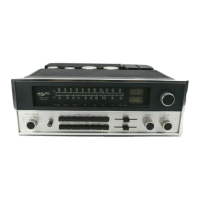Adequate ventilation extends the trouble-free life
of electronic instruments. It is generally found that
each 10° centigrade (18° F) rise in temperature re-
duces the life of electrical insulation by one half.
Adequate ventilation is an inexpensive and effective
means of preventing insulation breakdown that re-
sults from unnecessarily high operating tempera-
tures. The direct benefit of adequate ventilation is
longer, trouble-free life.
Allow at least 16 inches deep by 16 inches wide
by 6½ inches high for mounting the MAC 1900. Al-
ways allow for air flow by either ventilation holes
or space next to the bottom of the receiver and a
means for a warm air to escape at the top. With ade-
quate ventilation the MAC 1900 can be mounted in
any position.
To prepare for installation, remove the plastic pro-
tective covering from the MAC 1900. Turn it upside
down so that it rests on its top on the shipping pallet.
Remove the four plastic feet fastened to the bottom
of the chassis.
The design of the mounting template allows you
to position or locate the cutout from the front or rear
of the panel to which the instrument is to be mounted.
Position the plastic mounting template over the area
of the panel to be cut out for installation. The MAC
1900 must rest on a shelf behind the cabinet panel.
If the cutout is to be located from the front of the
panel, begin at step 2. If the cutout is to be located
from the rear of the panel, begin here.
1. On the back of the cabinet panel, scribe a
vertical centerline through the exact center of the
area in which the cutout is to be made.
Place the template against the back of the
panel and match the template centerline with the
centerline on the cabinet panel.
Make sure that the bottom of the template
rests on the shelf on which the MAC 1900 will sit.
Mark the two locating holes ("B" holes on the
mounting template).
Drill the two "B" locating holes. Be certain the
drill is perpendicular to the panel.
Now position the template on the front of the
panel by aligning the "C" locating holes on the
template with the drill holes.
2. If the cutout is to be located from the front of
the panel:
With the template in place against the cabinet
panel, mark the four small holes "A" that identify
the corners of the cutout. Join the corner marks
with a pencil. The edge of the template can be
used as a straight edge.
With the saw on the INSIDE OF THE PENCIL
LINES carefully cut out the rectangular opening.
The bottom of the cabinet panel cutout should be
even with the top of the shelf.
Fold the PAPER SHELF TEMPLATE along the
dotted line. The Paper Shelf Template is used to
locate the ventilation cutout and mounting holes
in the shelf. Put the dotted line against the front
of the cabinet panel. Align the center line of the
PAPER SHELF TEMPLATE with the center of the
cabinet panel opening. Mark the ventilation cut-
out outline and cut it out. Secure the MAC 1900
to the shelf with two machine screws.
2

